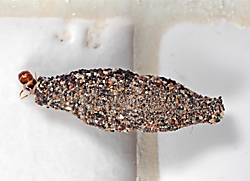Common Clothes Moth Species: Casemaking Clothes Moths

A common moth, the casemaking clothes moth is found specifically in the southern part of the US. These moths get their name from the case or cocoon they build around their bodies with the materials they consume.
Appearance
Casemaking clothes moths are the most easily found when they are in the case making stage, while they are larvae. Their cocoons are made of the materials they consume.
Key physical characteristics of the casemaking clothes moth include:
- Cases are 1/16 to 3/8 inches in size
- White or fabric colored cases
- Cigar-shaped cases often attached to fabric
- Adults grow up to ½ inch from wing to wing
- A dull cream color on wings
Habitat
Like most clothes moths, they can be found hiding in dark moist areas. Clothing moths take moisture from fabric materials such as sweat and urine to get their hydration.
Geography
Casemaking clothes moths are found all over the world as one of the most common moths. While their origin is unknown although they can be found across the globe, not just the southern states.
Diet
Casemaking clothes moths are in search of keratin, and animal-derived protein. Many household fabrics and upholstery are made from the keratin they are in search of. These moths like most, enjoy a dark and moist environment to stay tucked away.
These moths eat the following:
- Natural and synthetic fibers
- Wool
- Silks
- Carpets
- Paper starch
- Feathers
- Stored tobacco
- Felts
Threat
In general, clothes moths all eat and can destroy fabrics in the home. This can cause large amounts of frustration from the time spent dealing with an infestation and money to replace clothing and even furniture. With how fast moths can multiply while going un-noticed for some time, an infestation is likely before you realize there is a problem.
Control Options

- Trap Clothes Moths: For easy clothes moth control, use our safe and non-toxic, TERRO® Clothes Moth Traps. The traps contain a powerful pheromone lure that attracts moths to the trap’s sticky surface where they get stuck and die. Simply place the moth traps in areas where moths are observed.
- Wash All Clothing & Linens: Before storing fabrics ensure they are thoroughly washed to remove stains, spills or sweat that attract and feed the moths.
- Vacuuming: Vacuuming regularly helps to remove moth eggs that you can’t see hiding in carpets and drapes. Also, vacuum out the closest and drawers where clothes are stored.
- Cedar Storage: An old-fashioned tip, cedarwood blocks, hangers or even cedar chests are great aids in preventing infestations. Cedarwood contains natural oils that kill the larvae of clothes moths.
- Keep Fabrics Airtight: Fabrics that are more specific to attack such as wool should be stored in airtight bags/containers to prevent access to the moths.
